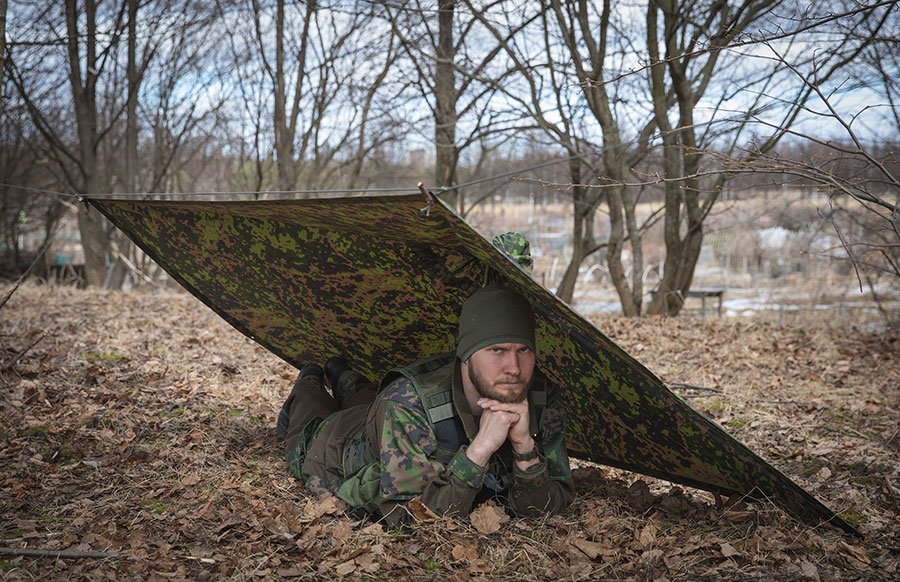
Using a rain cape as a shelter
Using a rain cape as a shelter
Even though there are all sorts of handy shelter options for outdoorspeople, ranging from a bivy bag to tents that fit several people, none of them are as versatile, lightweight, and atmospheric as a rain poncho.
This article was first published in August 2011. The text and photos were updated in September 2021 and further in June 2023.
The rain cape has been the accommodation of choice of many armies for a long, long time. This is not a surprise because its versatility makes it a perfect piece of military gear. Their development didn’t stop at the wars that make good Hollywood movies. Nowadays there are very high-tech but also expensive rain cape/shelter half combos, such as the OR WallCreeper.
In addition to a shelter, many rain capes can also be turned into stretchers to carry wounded soldiers from the battlefield. However, when one gazes upon these soft multi-tools, one can’t help to wonder whether they can still function as a rain cape. Luckily the answer is usually yes.

Romanian rain cape
When it comes to shelters, usually one’s knowledge or imagination limits things more than the fabric itself. Here are a few examples to give you some ideas.
Lean-to
If you only have one rain cape, a lean-to is the most natural shelter option. One cape can create a few different lean-to versions but they are all quick and easy to set up. Basically there are two main types; a lean-to open from all but one direction, and then the variations that are closed from more than one side.
Open lean-to

Särmä TST rain poncho as an open lean-to
This is the traditional version that most people visualize when they hear the word lean-to: One edge is against the ground and the opposite edge is hoisted up either with sticks, by tying it to trees, or a horizontal rope pulled between two trees. If you use sticks, you should secure them down using cordage because there aren’t many things more miserable than a collapsed lean-to on a stormy night. Also attach the other edge to the ground as well as possible, either by laying heavy rocks on top of it or with tent pegs if the rain cape has grommets or something similar.
This lean-to is more spacious than the one where the sides aren’t open. However, thus it also doesn’t shelter you as well, letting the wind in. And it only protects you from rain if the side that is attached to the ground is against the wind. You can make it more protective by lowering the upper edge but it also makes it more cramped and basically only fit for lying down.
More sheltered lean-to

Särmä TST rain poncho with one corner attached to a tree.
This is also known in Finland as a “loue”, although a traditional loue is made from a fabric that is sewn into this shape. If you make this from one rain cape, you will only fit one human or two hobbits inside. This shelter is made by attaching three corners to the ground and the fourth onto a stick or a tree. This gives you a lean-to that is open only to one direction, which then protects the sleeper also from the sides. Alternatively you can make a loue so that you use a flexible stick as a frame that follows the ridge of the fabric. This leaves the front of the shelter completely open.
This shelter type is very quick and easy to set up, and it only requires one piece of cord plus something to attach the corners to the ground. When attached to a tree, it also provides a very nice camouflage effect.
Both of these lean-tos have the added bonus that when you have a campfire, they also reflect some of the heat to the backside of the sleeper, which is quite nice when it is really cold.
There are also other ways to build lean-to shelters depending on the weather conditions, terrain, equipment, and your ingenuity.
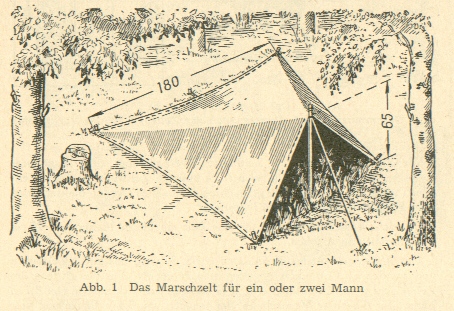 alt="A drawing of how to use a rectangular rain cape as a lean-to">
alt="A drawing of how to use a rectangular rain cape as a lean-to">
A clever way to use a rectangular rain cape. Best suited for short, slim, and agile people.
An A-frame lean-to requires so much material that one rain cape/rain poncho can only cover one prone person, and all the gear has to be left outside. When you button two capes together, you can fit two sleepers inside. The ends are left open, so the wind and rain can cause some discomfort, but the contraption still protects you better than an open lean-to.

Särmä TST rain poncho as an A-frame lean-to for one.

Two Belgian shelter halves as an A-frame lean-to.

When you look at details like this, you realize that using these as shelters isn’t a random application but carefully planned already at the drawing board.
Tent
When you have several rain capes, you can build all sorts of shelters, some of which can be called tents. Many old-time military rain capes are thus aptly named shelter halves. And especially those are easy to turn into shelters that actually protect you quite well from the evils of the world. There are lots of options, the most limiting factor of which is one’s imagination. Here are a few possibilities for you to try out.
A-frame tent
The A-frame tent is the classic shelter type familiar from Donald Duck comics. This is the tent for rugged outdoorspeople and those who like mosquitos. There are some rain capes that are particularly designed to be used for A-frame tents, so they have an end flap that can be closed with buttons.

The BW two-person tent is one of the most famous and most functional of the tents assembled from two rain capes.
There are several setup options: you can for example raise the tent using a cord tied between two trees or using separate tent poles. Try out different options to find out what suits you best.

Two Belgian shelter halves as an A-frame tent.
Even if your rain cape is designed to be used as an A-frame tent half, you can still use it when you travel solo. It makes an excellent lean-to that has side walls.
Polish version
By combining two Polish rain capes, you can build this tipi-like thing. With just one center-pole, the tent isn’t exactly very spacious but you don’t need to use any cordage outside, which reduces the risk of stumbling on any tripwires at night.

Polish rain capes as a tent.
Wehrmacht version
Wehrmacht had a funny way of fixing the field accommodation issues. They didn’t use shelter halves like the WWII Americans and post-war German Budeswehr and Austrian Bundesheer that copied the US system. Instead each German soldier had a triangular shelter piece. By combining four of these, you created a funny pyramid-shaped four-person tent (or a giant tent if you combined a bigger bunch of these).
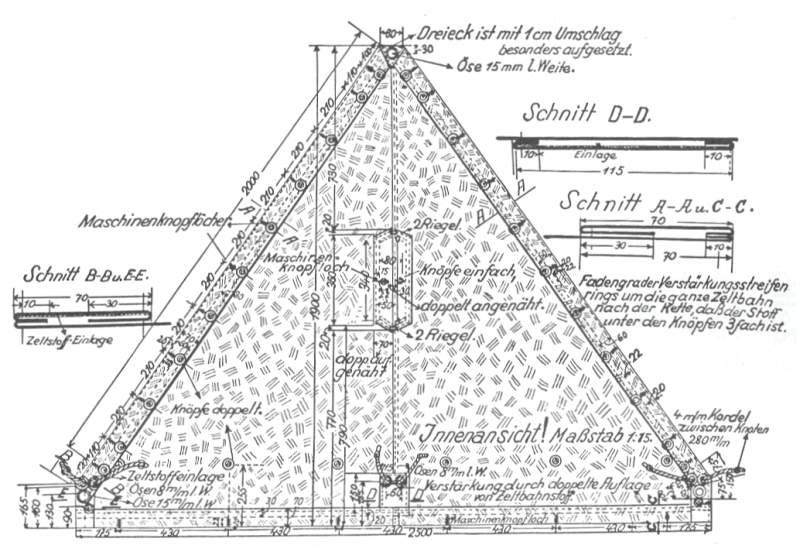 alt="Dimensional drawing of the Wehrmacht tent fabric.">
alt="Dimensional drawing of the Wehrmacht tent fabric.">
Dimensional drawing of the Wehrmacht tent fabric.
A pretty funny contraption all in all. However, if you wanna camp the WWII German way, you better make sure that all four of you are at most average-built. Otherwise there might be more physical contact than you are used to inside the tent. The tent fabric can also be used in many other ways. The link leads to a page that is old and ugly yet functional, just like the Zeltbahn itself!
The similar triangular model has also been used at least in Norway, Sweden, France, and some East European countries. Us Finns don’t have a similar tradition, which might be good when you think about the stuff distributed to soldiers in the army by the government.
Tents beyond your wildest dreams
Some countries, such as Belgium, Italy, and East-Germany decided to make their shelter halves awesome by sewing buttons, snap fasteners, or other fastening systems on all sides.
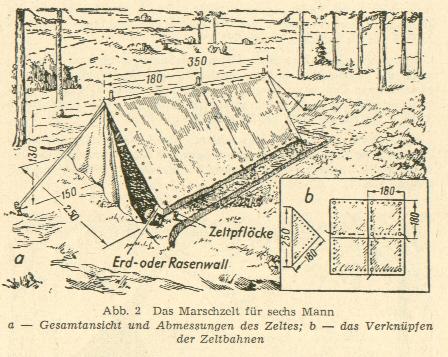
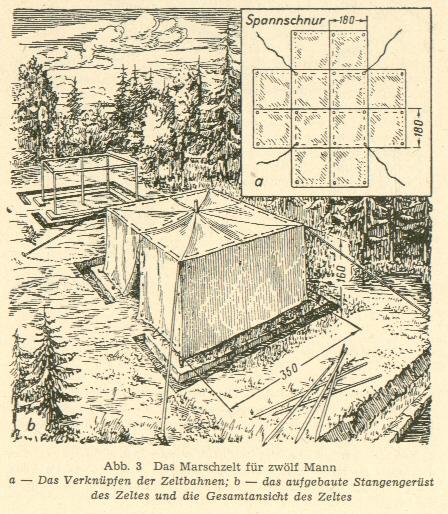
In practice this means that in addition to A-frame tents and lean-tos, you can build almost anything you want out of them, such as a garage for your bug-out vehicle or a huge cube!
Rain cape and hammock
Now we’re talking about a very minimalistic approach in both weight and functionality. This combo that only weighs c. 1.5 kg (3.3 lbs) eliminates the need for a tent, sleeping pad, and rain clothes.
A downside is that most rain capes will not completely cover the person lying in a hammock that easily. The bonus feature of a hammock is that it eventually spreads the moisture even to the areas that are covered by the rain cape.
To avoid - or at least to minimize - this problem, you have to build your hammock lean-to carefully. The best way to do it is to attach the opposing corners of the rain cape to the trees that hold the hammock, which makes the lean-to a bit longer. When you fix the leftover corners to the ground with tent pegs or cords, you have a lean-to that shelters you quite efficiently from all directions.
This shelter solution takes a bit of time, effort, and know-how but when done right, it is a very functional system worth trying.
Further tips
Tent pegs and poles
Most of the projects in this article become a lot easier if you use tent pegs and poles. You can carry these along in case the added weight doesn’t bother you. (You can also use hiking poles as tent poles, the telescopic ones are especially handy.) Or make your own in the forest, if allowed.
Cordage
You need some cordage in the bush because there are a million and a half ways to tie stuff up and down in the middle of nowhere. Especially vital in connection with lean-tos and tents, so keep some with you.
Impregnation
Many old school shelter halves/rain capes are made from cotton that has been treated with some magical stuff to make them water-resistant. The treatment can be decades old, so you might want to renew it with some suitable impregnation spray/liquid.
Glamping options
If you are fascinated by these kinds of shelters but a rain cape feels a bit too Spartan, you might want to look into a bit bigger tarps. We have a separate article on them as well!